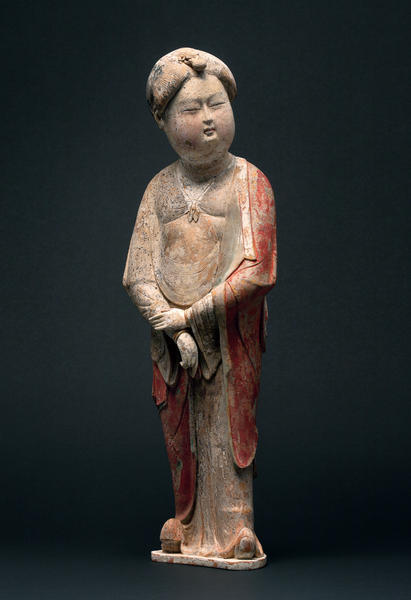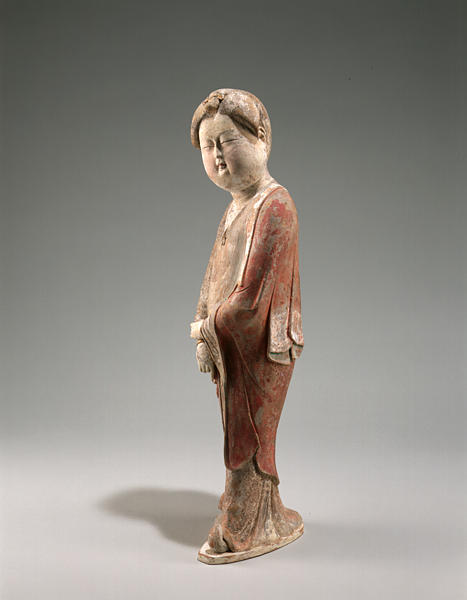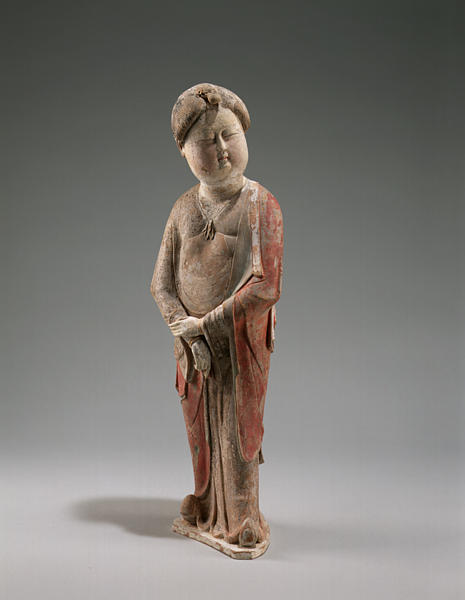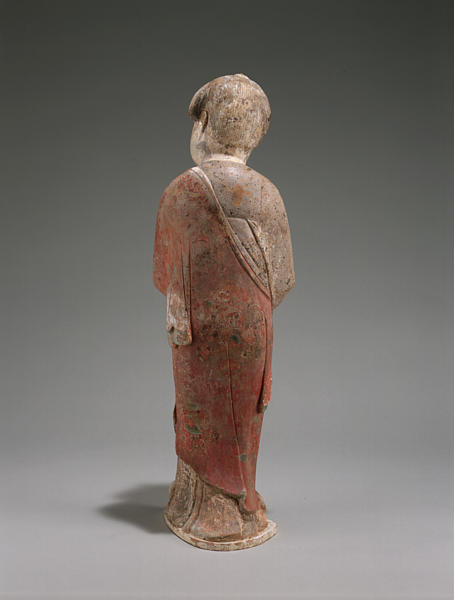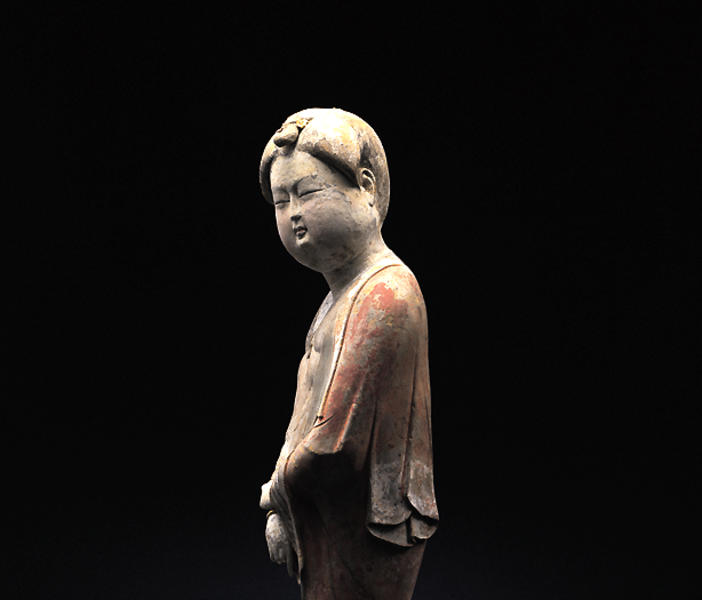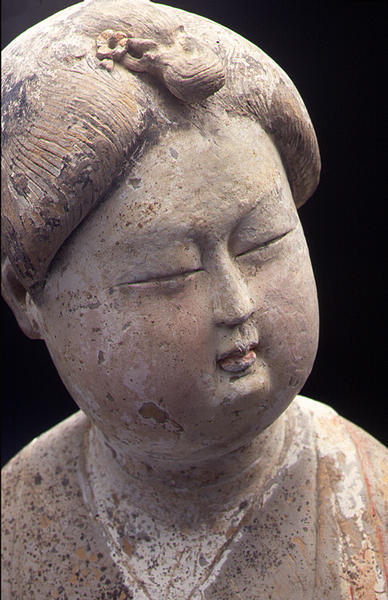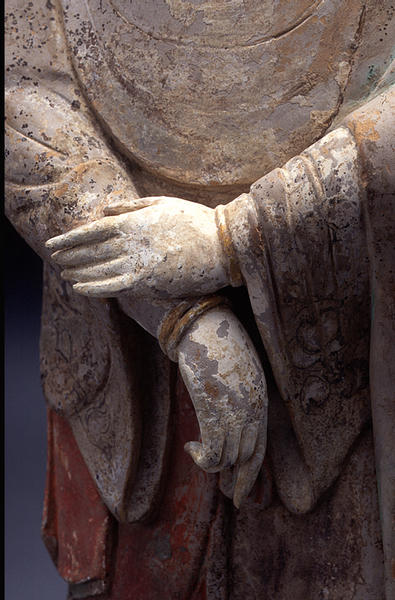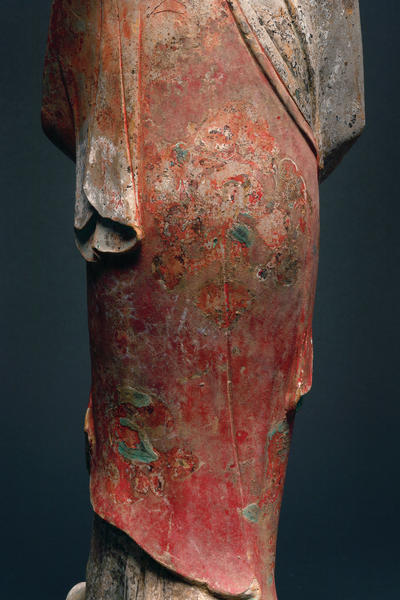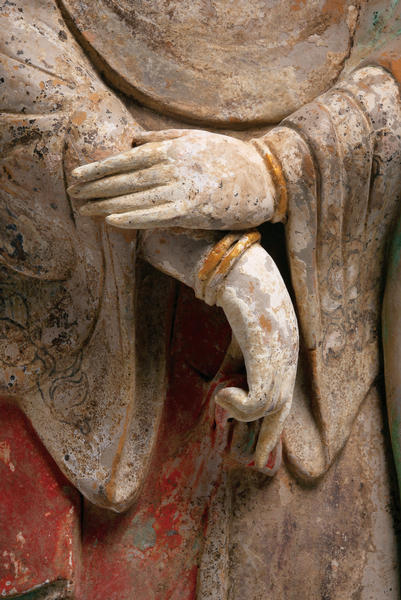宮女俑
- 中国
- 中国・唐時代
- 8-9c
- 陶器に着彩
- H-47.5
この上品で毅然とした唐美人は物思いにふけるような姿と表情が印象的な作品である。髪は上方で束ねられ、櫛や花文様のピンで止められている。赤褐色の陶土から塑造され、美しい肌合いと生きているような描写に仕上がり、質の高いものである。薄い長衣をまとい、長袖の上着を前で結び右肩にだけ通された外套を羽織っている。顔料による着物の表現も効果的で、繧繝彩色による植物文の痕跡も見ることができる外套を羽織った類例は極めて少なく、鍍金の腕輪をつけたものは他に類例が見られない。
唐代に流行した服装の女性俑である。爪先の反りあがった靴を履き、白い長袖の薄物の長衣にショールをまとい、左肩に袖を通さずに赤い胡服の上着をかけている。上着には宝相華文が繧繝彩色で描かれている。これらの多くは西域由来の装いであり、宝相華文も西域の植物文の影響から唐で発達した。盛唐にはこのようなふくよかな女性が美人とされ、副葬のための俑が型を使って多く造られた。しかしこの像は類例を見ないほどの繊細な造りと個性的な存在感があり、赤褐色の陶土から型を使わず塑造されたものと思われる。何らかの埋納以外の目的があったものとも想像されるが、高貴な雰囲気の面立ちに微妙なほほえみを湛えている。
Catalogue Entry
This elegant, beautifully garbed, and aristocratic Tang lady stands thoughtful and self-absorbed; her contemplative air reinforced by her stance and expression. Her head, turned to the left and slightly inclined to the right, displays the delicate features of a classic plump-faced Tang beauty: elongated narrow eyes, a small nose, and full, pursed lips with the barest hint of a smile. Described by fine incised lines, her hair has been fashionably swept up from the nape of her neck, pulled forward, and secured by a comb at the crown of her head; then, at the front, the gathered hair is parted, and folded over at the temples with the looped endsbound and secured in place with two-flowered, gilt hairpins.1
This exquisite lady appears to be modeled entirely by hand from reddish-brown earthenware, and the ceramic transformed into a sensuous range of textures. Embodying the sculptural hallmarks of Tang, the keenly observed form has been fully realized in the round, is equally well-finished on all sides, and is eminently satisfying from any angle. Her posture with its subtle contrapposto conveys a strong sense of immediacy.
Fashionably attired, the figure appears to be wearing a long thin robe with a seemingly diaphanous full-sleeved jacket or blouse tied delicately at the breast as well as a shawl that crosses the midriff and drapes over the right shoulder.2 The robe falls in elegant folds over the contours of her voluptuous body, reaching down to the upturned "cloud-toed" shoes and fanning out over the base. Over this robe, she wears a wide-lapeled coat loosely draped over her left shoulder and pulled under her right arm; one sleeve hangs empty down the left side of her back, while the other hangs empty below her right arm. The red coat, which retains light green pigment on the lapel and white on the border, effectively simulates a much heavier fabric than her robe. Traces of floral decoration painted in red, cream, and black can be found on the back and sleeves of the coat.
Her clothing includes two unusual features, the coat and the gilt bracelets. Only a very small number of Tang-period clay tomb figures or mingqi represent voluptuous ladies wearing coats; two examples have been excavated from the Xian area in Shaanxi province. However, these clay sculptures depict the coat draped over both shoulders with the sleeves hanging empty, one on each side.3 The magnificent Shumei lady has two plain gilt bracelets clearly modeled on each wrist. No presently known clay tomb sculpture of a female figure from the Tang period has gilt bracelets. In addition, this figure is very heavy for its size, with a tubular vertical channel hollowed out, probably, to prevent explosion in the kiln.4 The features, the bracelets coupled with the superb level of modeling, and the unusual construction of the figure raise the question of whether this is or is not a tomb sculpture. The figure may have been created for some purpose other than burial.5
ALJ
Catalogue Entry
This yong figurine shows a woman in clothing that was in vogue in Tang-period China: shoes with curled-back tips; a shawl over a thin, white, long robe with long sleeves; and a red foreign-style overgarment draped on her left shoulder without her arm in the sleeve. The overgarment is decorated with a baoxianghua (“precious flower”; Jap. hosoge) floral pattern rendered in “rainbow coloring.” Many of these fashions derived from the “Western Regions,” that is, Central and West Asia. The baoxianghua pattern, for example, developed in Tang China under the influence of Central Asian plant motifs. During the High Tang period, plump women of the type depicted in the present work were regarded as paragons of feminine beauty, and many figurines like this were produced from moulds as funerary goods. However, this particular example shows exceptionally delicate workmanship and has a distinctive presence. It is thought to have been formed from a reddish-brown clay without the use of a mould, and there is also conjecture that it was made for some purpose other than for grave burial. In any case, the figure’s distinguished-looking face is wreathed with a mysterious smile.
